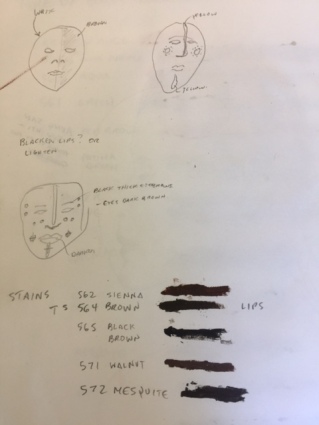(This is another instalment in the retrospective I’m doing for this website on the 10 masks I have – thus far – created)
It is 2010 or 2011 and I have moved – twice – since creating Túatha, the prototype for my series of masks adorned with antlers. Five years have elapsed and I am now living in a house in Kitsilano. Much has transpired since Tùatha was conceived (https://clayandbone.com/2016/12/13/death-mask-troubled-dreams-on-the-road-to-clay-bone/ )…and I feel the stirrings of the Muse. I’m still heavily engaged in the drinking process and have set up a “man cave” in the garage on our property. I’ve recently rediscovered the second set of antlers which I purchased at the same time as those which adorn Tùatha and have found – much to my surprise and delight – some remaining clay which was quite readily resurrected with a little bit of work and water. The man cave would serve as my studio where I would create my next mask based on the attached image of a shaman from Togo in a voodooistic trance.

Admittedly, this mask, with it’s white eyes and indeterminate expression has a slightly malevolent look. To me it seemed perfectly suited for the set of antlers which I had in my possession, and I was determined to depict it in clay.
As is true of all of my masks since Boko, I begin the process by creating one or several rough sketches of the subject. I find that this gives me a better feel for the shapes and contours that I will be trying to recreate, and gets me in touch with how the antlers will best be situated. It also allows me to create a larger image from which to work, and provides a copy that I don’t mind getting wet or stained during the messy mask-making process.


For the first several years of its life Mask #2 (as Boko was first known) remained nameless and unadorned. It began as a fairly simple reintroduction to the mask making process after a 5 year hiatus. I applied a dark brown glaze to try and match the skin tone in the picture, attached the antlers and let it sit until I opened my studio on Mayne Island, several years later. While on Mayne, I had a chance to reflect on this mask and had been influenced by events in northeastern Nigeria, where an islamist/extremist group named Boko Haram had been committing atrocities. I named him Boko – after the group – as a tacit recognition of the evil which can reside in all of us.
The picture to the right (above) was created on Mayne Island as I searched for ways to bring more human detail and life to Boko. The three face depictions have different examples of sub-saharan face paint that I gleaned from online research. I ultimately settled on a variation of the face paint example on the bottom left which is from the Wodaabe tribe – a small subgroup of ethnic Fulani nomadic herders in the Sahel. The variations of brown paint shown above were used to give more character and detail to the original glazed mask – especially to highlight Boko’s lips. The final result can be seen here:

